| YORKSHIRE - THE EAST RIDING - 3 |
|
Market Weighton - All Saints |
| Here are two examples of seemingly the most ordinary of monuments which have intersting tales to tell |
 |
 |
 |
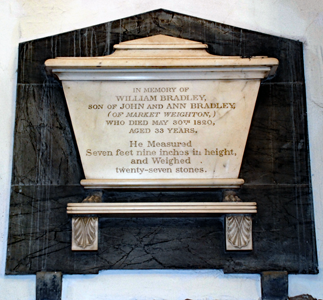 |
| Robert Barker (1748/9) and
his wife, Catherine (1773) Also three children: Robert, Rebecca, and Catherine |
Mary Evans (1776), and her husband, Bemjamin (1791) | Rev Geo. Skelding (1819) For 45 years vicar of this parish. Signed M Taylor, York |
William Bradley (1820) at 33 'He measured 7 foot, 9 inches and weighed 27 stone' |
 |
 |
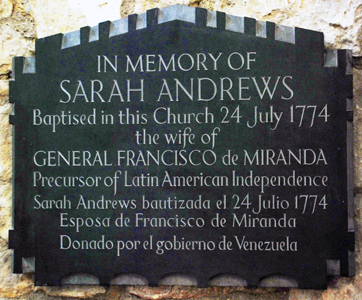 |
| Anne Pulleine (Smith) (1851) Her son, Robert James Pulleine (n/d) Her brother, John Smith (1868) |
Mary Rivis (1804) and her
sons: William Robert (1834), Iohn (1822), George (1817), & Thomas (1807) Her husband, Iohn (1844) |
Sarah Andrews (no date) In English and Spanish see below |
| Sarah Andrews |
Sarah Andrews was presumable born in Market Weighton in 1774. At some point, she became the housekeeper to General Francisco de Miranda and they later married. This was likely when he was living in London after his involvement in the French Revolution. I do not know the date of her death or where she was buried, although this was presumably in Venezuela. What a story she would have been able to tell! Click on the link of the General to find more information. The General himself was arrested and spend the last years of his life in a Spanish prison being buried in a mass grave. An empty tomb awaits him in Venezuela. |
| Pevsner: Yorkshire: York and the East Riding |
I was pleased to see that all the above monuments - with a little information about them - are included in the above volume. The would never have been the case in the original volume and I note that this particular volume has been revised by David Neave, who is a senior lecturer in history at the University of Hull and takes a more topographical approach. A welcomed change. |
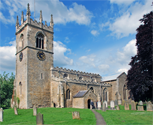 |
North Cave - All Saints |
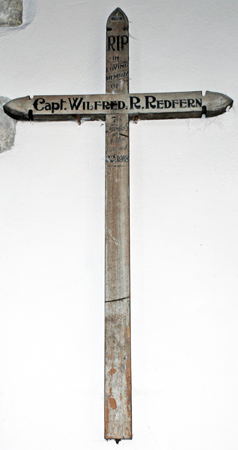 |
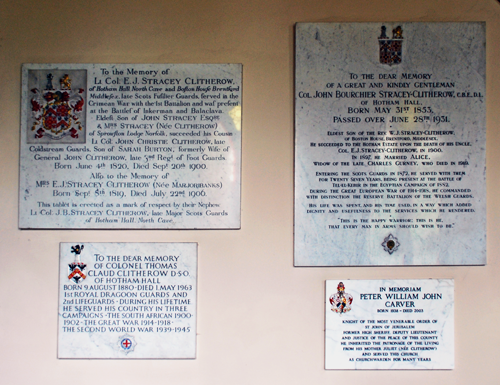 |
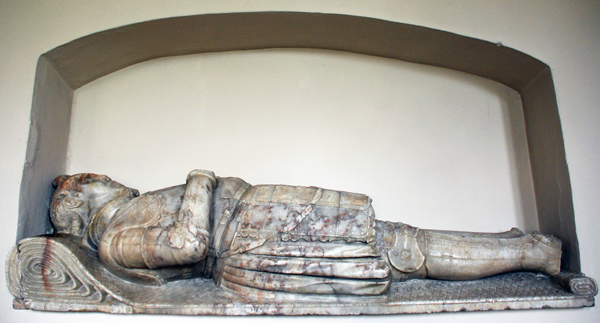 |
| Captain Wilfred R Redfern (1918) | The slightly abridged text is given below
if now readable in the photograph. Note the curious - and somewhat inconsistent use of the long s of the top left tablet |
Possibly Sir Thomas Metham (1610).
Tomb chest lost His wife's effigy is shown below a window. There is a reference to this monument on the stone shown below. |
| Lt Col E J Stracey Clatheroe (1900) Late Scots Fuſilier Guards; ſerved in the Crimea War with the 1st Battalion and waſ preſent at the Battleſ of Inkerman and Balaclava Also Mrs E J Stacey Clitherow (Marjoribanks) (1906) |
Col John Bourchier
Starcey-Clitheroe OBE DL (1931) (Nephew of Lt Col E J Stracey Clitheroe left) Served with the Scots Guards for 27 years, having been present at the Battle of Tel-El-Kebir in the Egyptian Campaign of 1882. During the Great European War of War 1914 - 1918 he commanded with distinction the Reserve Battalion of the Welsh Guards |
|
Colonel Thomas Claud Clitherow DSO (1963) 1st Royal Dragoon Guards and Second Life guards... ...he served his country in three campaigns - The South African War 1900-1902 - The Great War 1914-1918 - The Second World War 1939-1945 |
Peter William Carver (2003) Knight of the Most Venerable Order of St John of Jerusalem |
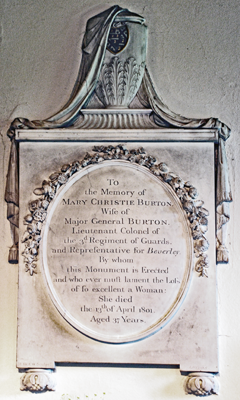 |
 |
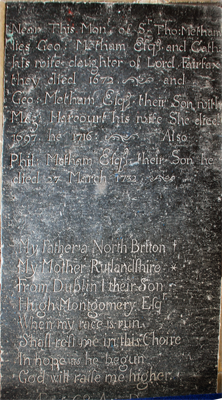 |
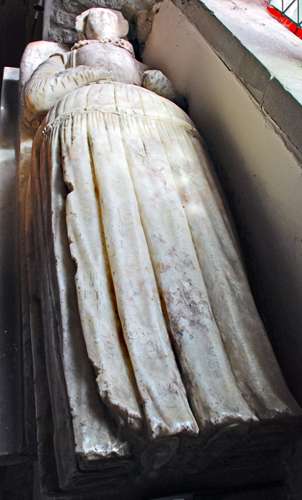 |
| Mary Christie Burton (1801) Wife of Mjr Gen Burton By H. Rouw 'Modeller to His Majesty, New Road London |
Rich'd Burton (1784) Late Cpt in his Majesty's 3th Reg't of Foot |
See below for a transcript of the inscripton |
| Near this mon't of Sr Tho: Metham lies Geo: Metham Esq and Cath: his wife daughter of Lord Faiffax. they died 1672 [the second date has not been written] Geo: Metham Esq their Son with Mag Harcourt his wife She died 1697. he 1716. Also Phil: Metham Esq their Son he died 2th March 1732 |
My father a North Barton My Mother Rutlandſire From Dublin I their son Hugh Montgomery Eſsr When my race is run Shall reſt me in this Choire In hope as he begun God will raiſ me higher [the date is covered] |
| Pevsner (revised
David Neave) writes 'the ledger stones to Hugh Montgomery
(1748) Barbara Montgomery (1747) have a curious rhyming
inscriptions.' The former must refer to the stone above
and his wife presumably has a second stone. I have not
discovered the relationship of the Methams to the Mongomerys to
explain why the stone is shared. To add: 1. James Pinkerton (1781). An Adamesque frieze with scrolled pediment and urn. He was contractor for the Market Weighton canal. 2. John Foster (1816) Urn. By John Earle, Hull 3. Rev Richard Todd (1830) Also by the above 4 & 5. Nathan Jowett Baron (1841) and Sarah Baron (1844) Both by R Brown, London 6. George Barton (1854) A copy of the last by Simpson & Malone of Hull |
 |
Patrington - St Patrick |
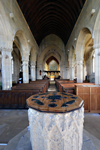 |
| The church with
the well known spire which can be seen for miles. The
church is unlocked, warm and welcoming and there is a
very large free car park in front of the church, which
may be seen in the photograph. O/S Ref: TA 316 226 |
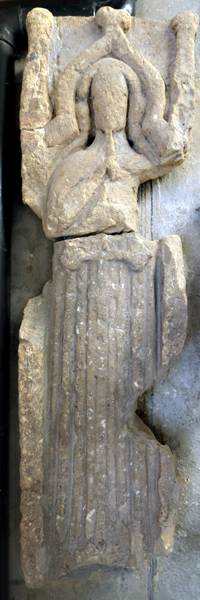 |
  |
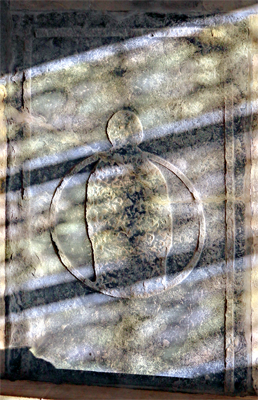 |
|
Left: Lady (early - mid 14th
century) Stone effigy with gablette, mutilated. From
Kilnsea church Above: Grave slabs (13th - 14th centuries) Right: Robert Patrington, priest. (later14th century) Treasurer of York Minster. Brass indent of half effigy within circular inscription. Sorry about 'arty' lighting! Below: 1. Jane Featherstone (1803) 'in the 25th year of her age. 2. Illegible name. (180_) Also Sarah his wife 'who died with her infant Child (1804). 3. Susanah Featherstone (1808) And her eldest daughter, Mary Anne (1804) 'Aged 32 years'. 4. Elizabeth (1813) and Edward (1821) Thorpe. 5. William Rank (1770) Worn and damaged brass Far below: 1. George Hibbert Marshall (1888). 2. Henry Edward Maddock MA 16 years rector. 3. Walter James Marshall (1899) The groining of this aisle was completed in his memory. 4. George French (1802) |
||
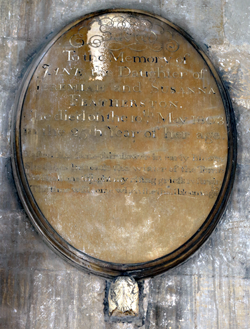 |
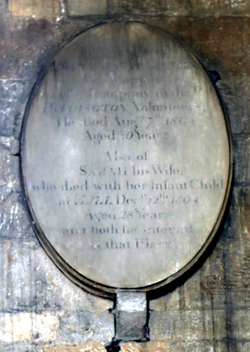 |
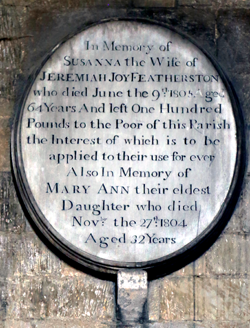 |
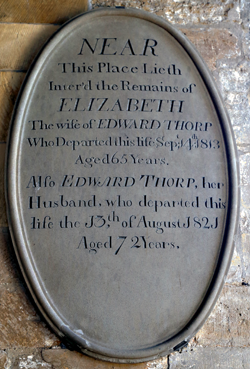 |
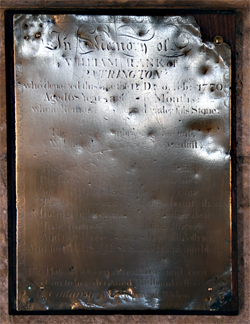 |
 |
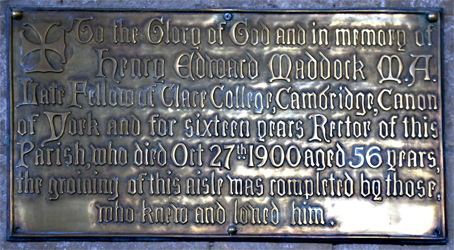 |
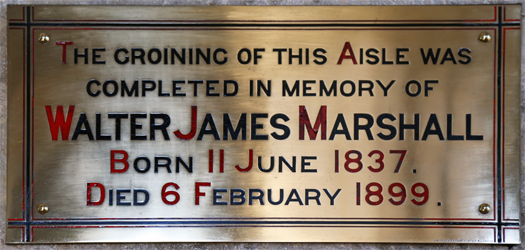 |
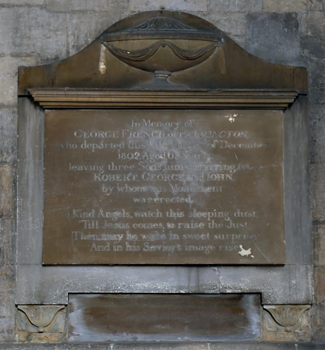 |
||
| A number of other monuments are described but we were unable to find them; they may be in a locked room with low wall, low enough to see them but too high to photograph them. Oval wall monuments are described 1796-1813, as well as two other brass indents. Also John Duncalf (1637) & Emot Shaw (1652) Brass inscriptions. Mary Robinson (1763) Urn with finial. Mary French (1782) Fluted pilasters. Robert Robinson (1783) Scrolled pediment. Mary Pearson (1800) Pediment and urn | |||||
| Pocklington - All Saints |
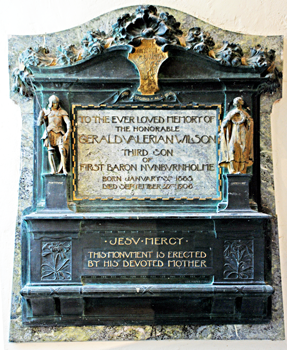 |
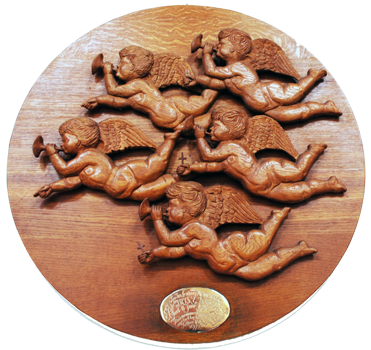 |
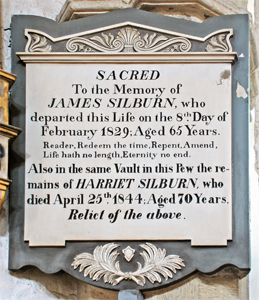 |
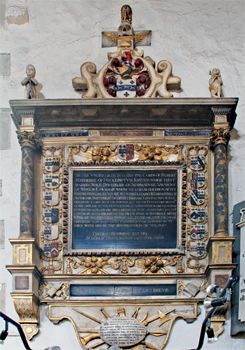 |
| The Hon Gerald Valerian Wilson (1903) | Iris Judd (1970) | James Silburn (1829) 'Also in the same Vault in this pew the remains of Harriet Silburn...' (1844) | 'HEARE VUNDER LIETH INTERED THE CORPS OF...' Robert Southebee (1594). Alabaster |
 |
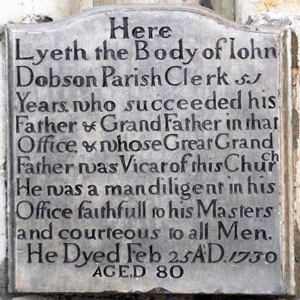 Here Lyeth the Body of Iohn Dobson Parish Clerk 51 Years. who succeeded his Father & Grand Father in that Office & whose Great Grand Father was Vicar of this Church He was a man diligent in his Office faithfull to his Masters and courteous to all Men. He Dyed Feb 25 AD 1730 AGED 80 |
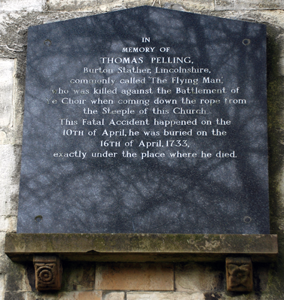 IN MEMORY OF THOMAS PELLING, Burton Stather, Lincolnshire, commonly called 'The Flying Man', who was killed against the Battlement of Ye Choir when coming down the rope from the Steeple of the Church 1733. This Fatal Accident happened on the 10th of April, he was buried on the 16th April 1733 exactly under the place where he died. The monument is outside the church and replaces the original which had become decayed |
| Thomas Dolman (1589) Black marbe triptych with incised recumbent effigies of husband and wife in centre and kneeling children on either side |
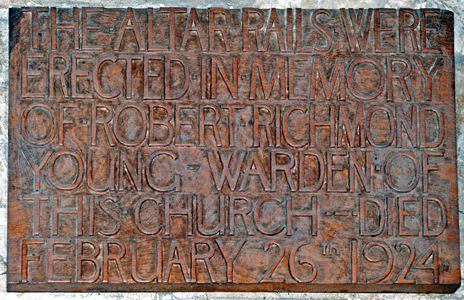 |
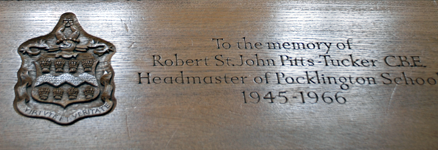 |
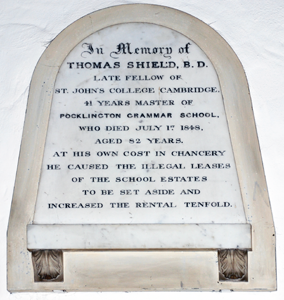 |
| The Altar Rails were erected in memory of Robert Richmond Young - Warden of the Church 1924 | Robert St. John Pitts-Tucker
CBE Headmaster of Pocklington School 1945-1966 |
|
| Thomas Shield BD 41 years master of Pocklington Grammar School 1848 |
||
| Other Monuments | |
| Margaret Easingwold, Prioress of Wilberforce Priory. 14th Century incised slab with lead filled foliated cross. Black letter inscription added in 1512 (by pulpit) | Mid to late 14th century slab with indents for brass of head and hands of a lady. Also for figures of saints, inscription and Evangelists' symbols |
| Walter Staveley (1780) Obelisk | Seth Stables (1830) Weeping female by sarcophagus |
| Nathaniel Holmes (1835) Neoclassical by Waudby, York | Mary Dewsbury (1846) Sarcophagus and urn. by Waudby, York |
 |
Swine - St Mary |
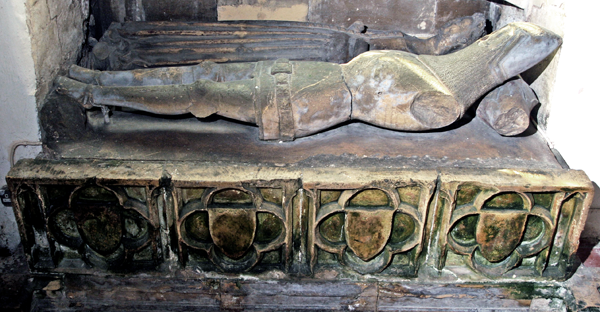 |
|
| Knight/Lady c. 1400 on tomb chest with shields in quatrefoils. Probably the tomb recorded which had Sutton arms in 1584; if so possibly Sir Thomas 'Lord' Sutton (c 1384) and Wife. |
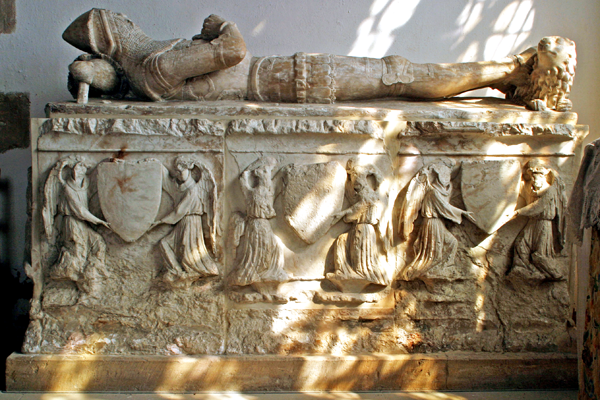 |
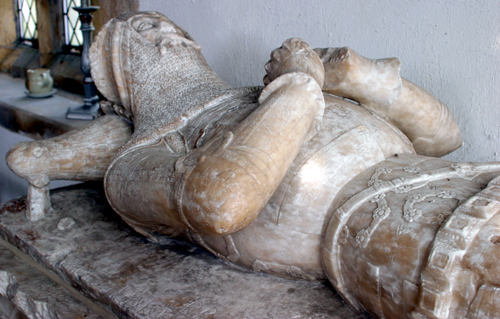 |
| Knight of c 1410 on tomb chest with pairs of kneeling angels holding shields, alabaster. The base is a 13th century grave slab with incised cross. Arms of Hilton of Hilton (differenced) quartering Hilton of Swine but not indentified. |
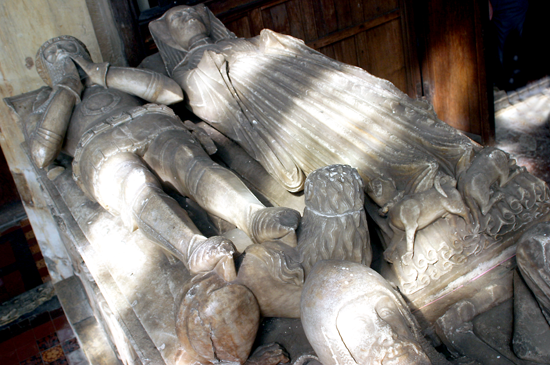 |
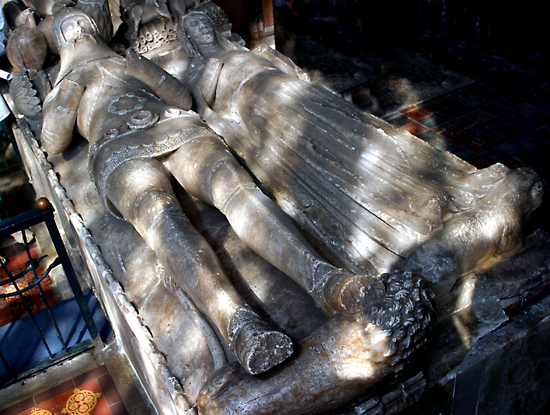 |
| On the left is
a Knight/Lady of
c 1410-20, on
tomb chest with pairs of angels holding shields,
alabaster. Arms of Hilton of Swine. Either
Robert III of Swine (c
1400) and one of his wives,
or Robert IV (c
1431) and his wife Joan. On the right ( and you could just see the heads on the previous photographs) is Sir Robert Hilton (1363) & Maud (probably), knight/lady of 1360-70 on tomb chest with shields and one remaining kneeling mourner; alabaster. Arms of Hilton of Swine. Below is a close up photographs of this monument. |
|
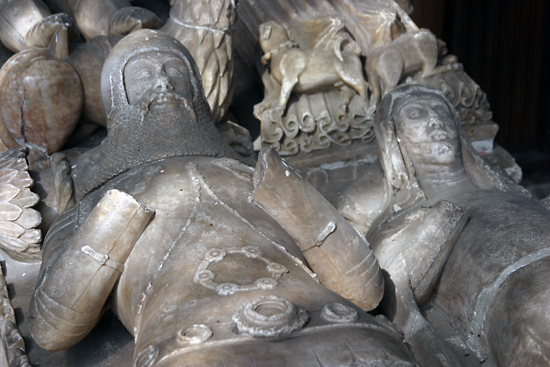 |
| This information in this section was adapted from that written and provided by Philip Lankester 2006 at the Beverely Church Monuments Society symposium that year. |
|
|
|
 |
Sledmere - St Mary |
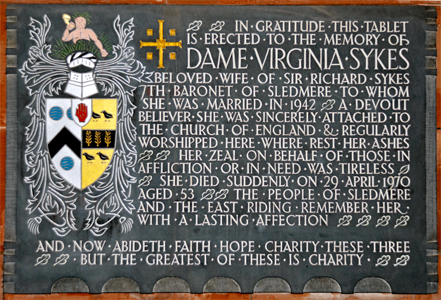 |
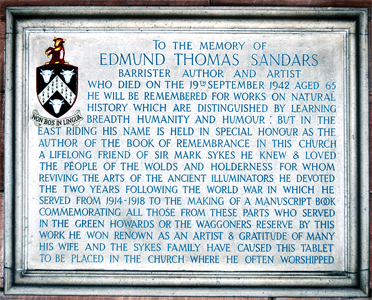 |
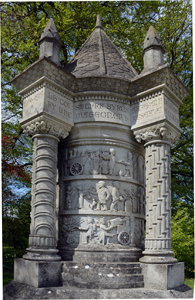 |
| Dame Virginia Sykes (1970) Wife of the th Baronet |
Edmund Thomas Sandars (1942) Barrister, Author and Artist |
|
|
| The Exhumation of Sir Mark Sykes |
Sir Mark had been buried in a lead lined coffin in the churchyard at Sledmere. It was believed that such a coffin would help to slow down decomposition of the body and preserve the H1N1 virus intact, so a team of virologists lead by John Oxford applied for permission to the Diocese of York for exhumation of the body. They intended to make the study under laboratory condition and to discover whether Sir Mark's death was caused by the virus itself, by a concurrent virus and bacterial infection, of by a cytokine storm in which the virus triggers an abnormal and excessive immune response with the immune system turning on and destroying the human host itself. It was hoped that all of this would help in prevention and treatment in the event of a further pandemic. Permission was generously given for this exhumation by living members of Sir Mark's family and, after a two year process, permission was finally gained form the Diocese of York. The exhumation took place in 2008. However the researchers were to be disappointed: the coffin had split owing to the weight of soil on it and the body was badly decomposed. The coffin was allowed to remain in situ and samples of lung and brain tissue were removed through the split. Soon afterwards the grave was refilled. I have not found a report on the results of this study. |
|
|
|
|
|
|
 |
Welwick - St Mary |
 |
| The church does not have a car park and parking outside is not possible as it is on a bend controlled by traffic lights. Rather drive into the village and park there; it is about 250 yards walk back to the church. The church is open. O/S Ref: |
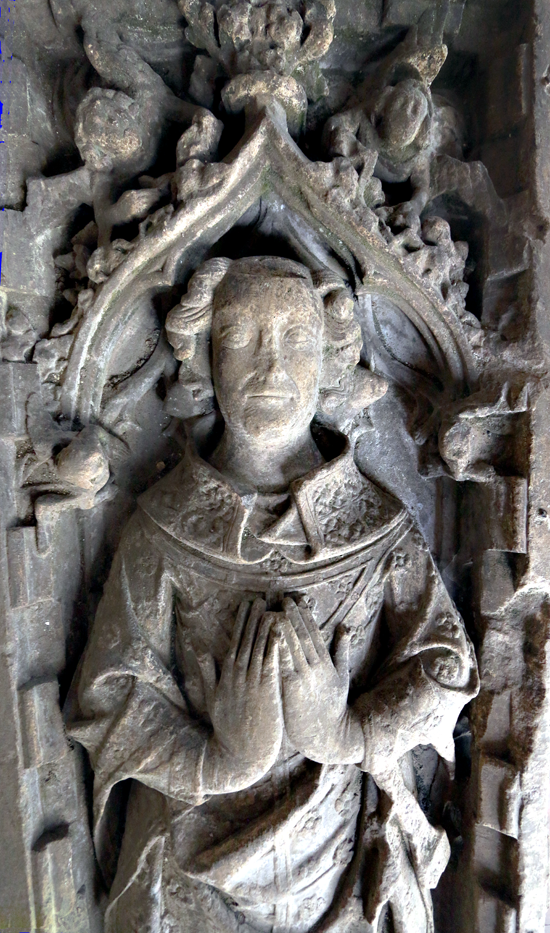 |
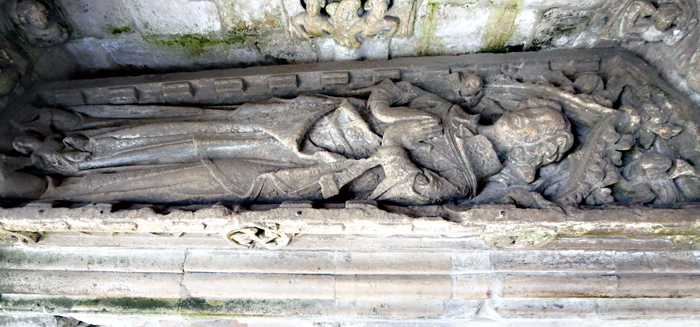 |
 |
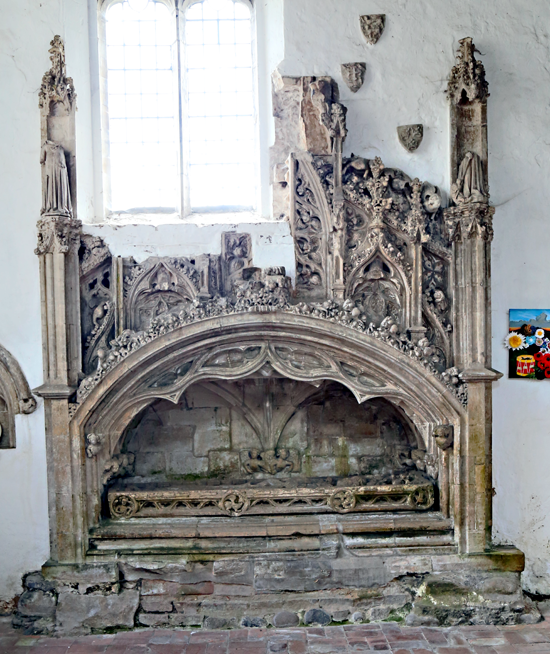 |
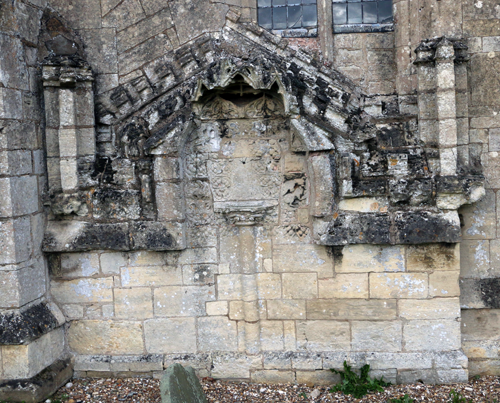 |
|
William de la Mare, Provost of Beverley (1338-60) or
his brother Thomas de la Mare, Vicar of Welwick
(1358) or Priest (1340-50)
Sunk effigy in mass vestments on curvilinear tracery. Front
border of slab has four medallions with signs of the
Evangelists. Figures of female saints in niches on flanking
buttresses. Above is stonework outside the church corresponding with the monument inside, presumably supporting structure. Note the the upper east part of the canopy has been cut away to allow for the insertion of a later window. |
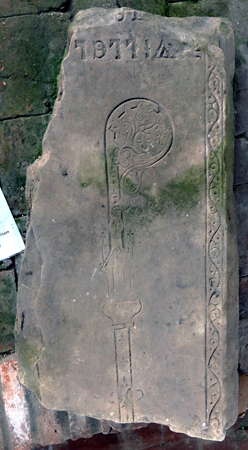 |
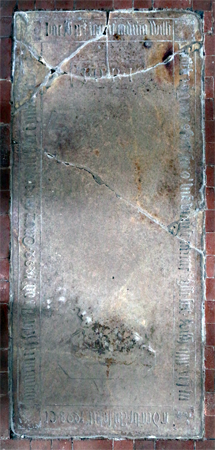 |
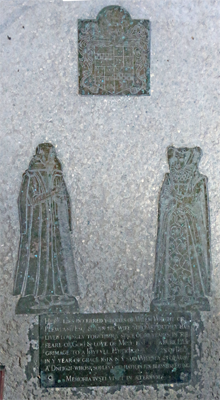 |
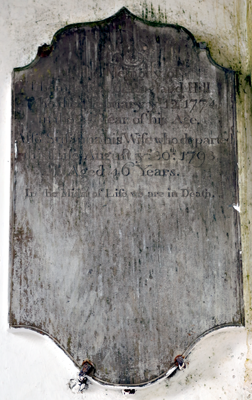 |
|
William (1350-60)
Grave slab with incised crosier head and name incised in
Lombardic characters. Excavated at Plowlands Farm 1/2 mile west. |
William & Margaret Sottleler (1498) Floor slab with incised tau cross and black letter marginal inscription | William & Ann Wright of Plowland (1621) Brass. He was stepbrother to two of the gun powder plotters | Thomas Fox (1774) snd Susanna (1794) |
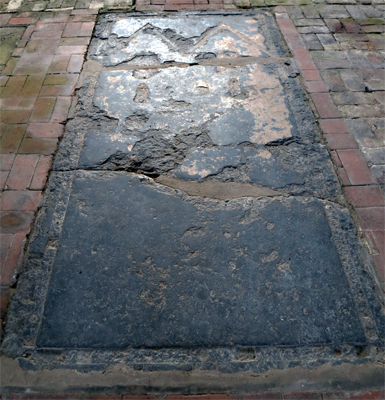 |
 |
|
| Left: Could this description refer
to the damaged slab on the left:
Civilian & Wife (later 14th
century) Floor slab, incised except head and
hands of figure, marginal inscription and parts of canopy which
would have been inlaid with brass? If it does - and we could
find nothing else - it is certainly rather optimistic. Above: Child's coffin
|
The drawings are by William I'Anson except for the Percy Tomb, Beverely, which was by the Web Master and used for a symposium poster
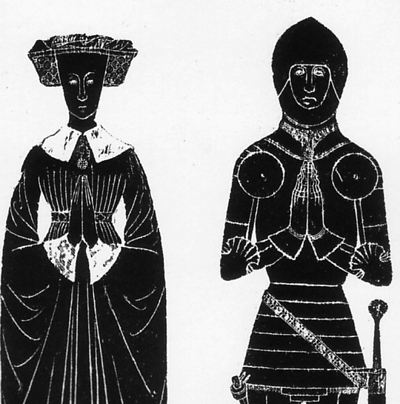 A
de Routh, Knight & Lady
(c 1420) under double canopy. (shown)
A
de Routh, Knight & Lady
(c 1420) under double canopy. (shown)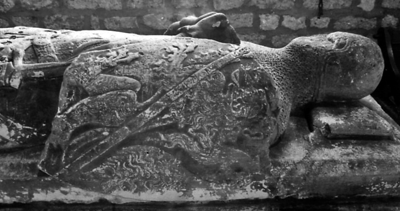 Sir John de Sutton (1357)
Effigy with straight legs on tomb chest with shields in
quatrefoils. Shield with carved arms (shown)
Sir John de Sutton (1357)
Effigy with straight legs on tomb chest with shields in
quatrefoils. Shield with carved arms (shown)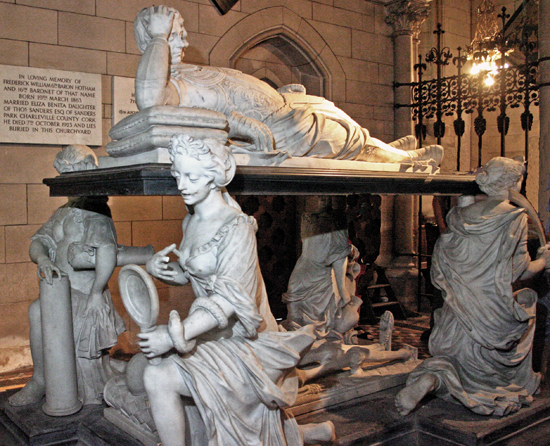
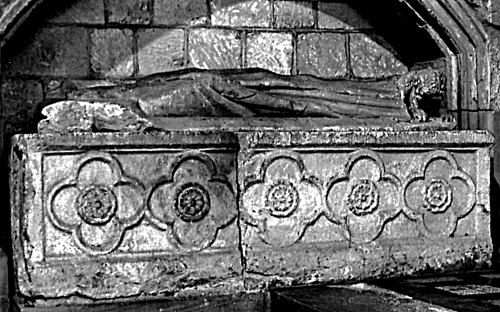
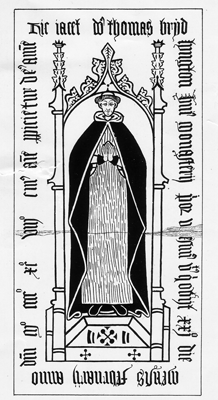 Left: Thomas
Bridlington, Prior of Warter (1498) Found in
the excavations in 1899 and reburied so no longer
visible.
Left: Thomas
Bridlington, Prior of Warter (1498) Found in
the excavations in 1899 and reburied so no longer
visible.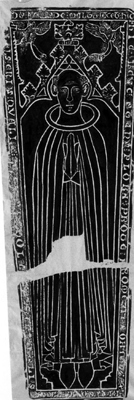
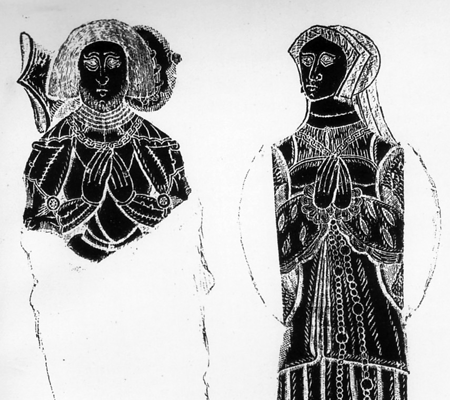
.png)